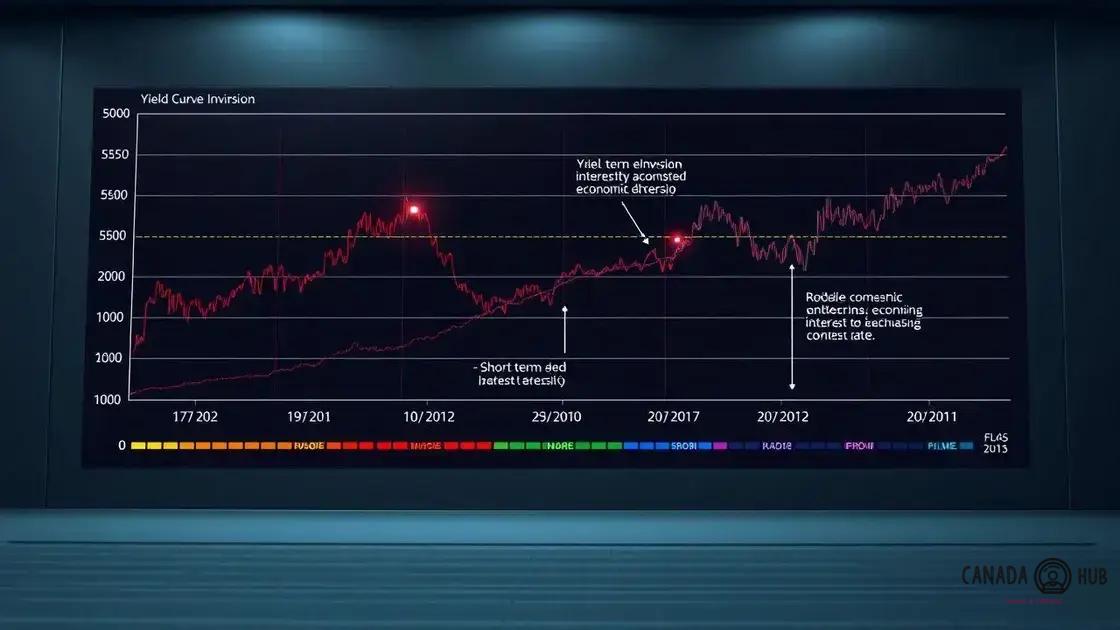Yield curve inversion highlights growing recession fears

Yield curve inversion highlights growing recession fears as it indicates long-term interest rates falling below short-term rates, signaling potential economic slowdown and impacting investment strategies.
Yield curve inversion highlights growing recession fears, a trend that has caught the attention of many economists and investors alike. What does this mean for you and the overall market? Let’s dive deeper into this intriguing financial phenomenon.
Understanding yield curve inversion
Understanding yield curve inversion is essential for grasping the fundamentals of financial markets. It represents a situation where long-term interest rates fall below short-term rates. This phenomenon often raises red flags about potential economic downturns.
The yield curve is typically upward-sloping, indicating that longer-term investments yield more return. However, when this curve inverts, it suggests that investors expect economic slowing ahead. Let’s explore how this inversion works.
What Causes Yield Curve Inversion?
Several factors contribute to yield curve inversion:
- Investor expectations of lower future interest rates.
- Central bank monetary policy changes.
- Increased demand for long-term bonds.
- Economic uncertainty leading to market volatility.
As these elements come into play, they shift the balance of risk and reward. Hence, investors look for safer long-term investments, driving yields down. But how does this affect the economy?
Impact on the Economy
When a yield curve inversion occurs, it can influence financial decisions across markets:
- Banks may tighten lending criteria.
- Businesses may delay expansion plans.
- Consumers could reduce spending.
This chain reaction contributes to economic slowdown, further validating the inversion’s significance. Notably, historical data shows that every U.S. recession in the past 50 years was preceded by this phenomenon.
In summary, understanding yield curve inversion is a vital part of interpreting economic signals. By recognizing these patterns, market participants can better navigate potential risks and make informed investment choices.
Historical context and its significance

The historical context of yield curve inversion provides valuable insights into its significance for the economy. Over the decades, this financial phenomenon has been a reliable predictor of recessions.
For instance, during the late 1970s and early 1980s, the yield curve inverted prior to economic downturns. This pattern repeated in the early 2000s and again just before the 2008 financial crisis. Understanding these instances can help us connect the dots between yield curve inversions and economic activity.
Key Historical Instances
Several notable occurrences of yield curve inversion stand out:
- 1980 Recession: The yield curve inverted, indicating an impending economic slowdown.
- 2000 Dot-com Crash: The inversion signaled that the tech bubble was about to burst.
- 2007-2008 Financial Crisis: This inversion preceded the major economic collapse, impacting markets globally.
These examples illustrate how economists and analysts use the yield curve as a gauge for future economic health. The trend raises questions and prompts discussions among financial experts regarding the implications for investors and consumers.
As we explore further, it becomes evident that the significance of yield curve inversions goes beyond mere statistics. They inform us about investor sentiment and expectations regarding economic conditions. When the curve inverts, it reflects a shift in how money flows in the economy, often leading to tightened monetary policy and a slowdown in growth.
Impact on the economy and markets
The impact of yield curve inversion on the economy and markets is profound. This phenomenon often signals changing economic conditions, raising alarms among investors and analysts. Generally, an inverted yield curve can lead to shifts in consumer behavior and investment strategies.
When the yield curve inverts, it indicates that investors are expecting a slowdown. This anticipation can lead to cautious spending habits among consumers. As uncertainty grows, businesses might delay investments, opting instead to conserve cash.
Effects on Investment Strategies
Investors often respond to a yield curve inversion by:
- Shifting towards safer assets, like bonds.
- Reducing exposure to equities, particularly in riskier sectors.
- Seeking alternative investments or strategies that might offer protection.
These preventive measures can create a ripple effect throughout financial markets. When investors flock to bonds, it can drive prices up and yields down, further deepening the inversion.
Sector-Specific Impacts
Financial institutions can feel the pinch from an inverted yield curve. Banks typically borrow at short-term rates and lend at long-term rates. When the curve inverts, their profit margins shrink, impacting lending capabilities.
In contrast, sectors like utilities often become attractive during these periods due to their stable revenue sources. Investors may prioritize stocks that offer reliable dividends over higher-risk investments, favoring stability during uncertain times.
Overall, the implications of yield curve inversion extend beyond just numbers. They profoundly influence economic sentiment and decision-making on both consumer and corporate levels. Recognizing this impact can help investors and consumers navigate turbulent financial waters.
How investors should prepare

As yield curve inversion signals potential economic troubles, investors need to know how to prepare effectively. Understanding this trend can help individuals and businesses make informed decisions about their finances.
First, diversifying investment portfolios becomes crucial. By spreading investments across various asset classes, such as stocks, bonds, and real estate, investors can reduce risks associated with economic downturns. This strategy can provide a buffer against market volatility.
Strategies for Investing During Uncertainty
During periods of yield curve inversion, investors might consider the following strategies:
- Investing in defensive stocks, which tend to perform better in downturns.
- Focusing on high-quality bonds that can offer safety during instability.
- Securing cash reserves to take advantage of future investment opportunities.
Another important preparation step is to stay informed. Following economic news and trends helps investors gauge market movements. Understanding indicators like inflation rates and interest rate changes can provide context to the inversion.
Consulting with Financial Advisors
Engaging with a financial advisor may also be beneficial. Advisors can offer insights tailored to individual financial situations and help navigate complex market conditions. Their experience can be invaluable in developing a strategic plan aligned with long-term goals.
Ultimately, preparation involves a combination of proactive investment strategies and a keen awareness of economic signals. By taking these steps, investors can better position themselves to manage potential risks associated with yield curve inversions.
Future outlook and expert predictions
The future outlook regarding yield curve inversion and its implications is a critical topic among economists and financial analysts. As market dynamics continue to evolve, understanding these trends becomes vital for investors.
Experts generally agree that a sustained yield curve inversion often indicates increased recession risks. As seasoned analysts assess current economic indicators, they provide various predictions based on historical trends.
Key Predictions for the Coming Years
Several insights have emerged from expert analyses:
- Increased volatility: Markets may experience heightened fluctuations due to uncertainty and investor sentiment.
- Corporate borrowing costs: If the inversion persists, companies may face tougher financing conditions.
- Future interest rate adjustments: Central banks might shift policies to counteract slowing growth, potentially impacting the yield curve.
In addition to these projections, experts emphasize the importance of monitoring ongoing global events. Factors such as geopolitical tensions and supply chain disruptions can significantly influence economic conditions. Therefore, staying informed about world affairs is essential for understanding market trends.
Outlook for Investors
As investors look ahead, they should remain alert to the signals that yield curve inversions send regarding economic health. Adjusting investment strategies according to expert predictions can be instrumental. By focusing on defensive positions and diversifying portfolios, investors can navigate potential downturns more effectively.
Overall, the future of yield curve dynamics depends on a complex interplay of economic factors and external influences. With careful consideration and proactive strategies, investors can better prepare for what lies ahead.
In conclusion, understanding yield curve inversion is crucial for navigating economic uncertainties. This phenomenon signals potential recessions and impacts investment strategies significantly. By recognizing historical patterns and expert predictions, investors can better prepare for future market dynamics. Taking proactive steps, such as diversifying portfolios and staying informed, helps mitigate risks during turbulent times. Staying ahead of these trends not only protects investments but also allows for informed decision-making in challenging economic landscapes.
FAQ – Frequently Asked Questions about Yield Curve Inversion
What is yield curve inversion?
Yield curve inversion occurs when long-term interest rates fall below short-term rates, indicating potential economic slowdown.
How does yield curve inversion impact investments?
It often leads investors to seek safer assets, like bonds, and may trigger a shift towards defensive stocks.
What historical examples exist of yield curve inversion?
Past inversions, like those before the 2008 financial crisis, have reliably predicted economic recessions.
How should investors prepare for yield curve inversion?
Investors should diversify their portfolios, stay informed about economic trends, and consult financial advisors for guidance.





